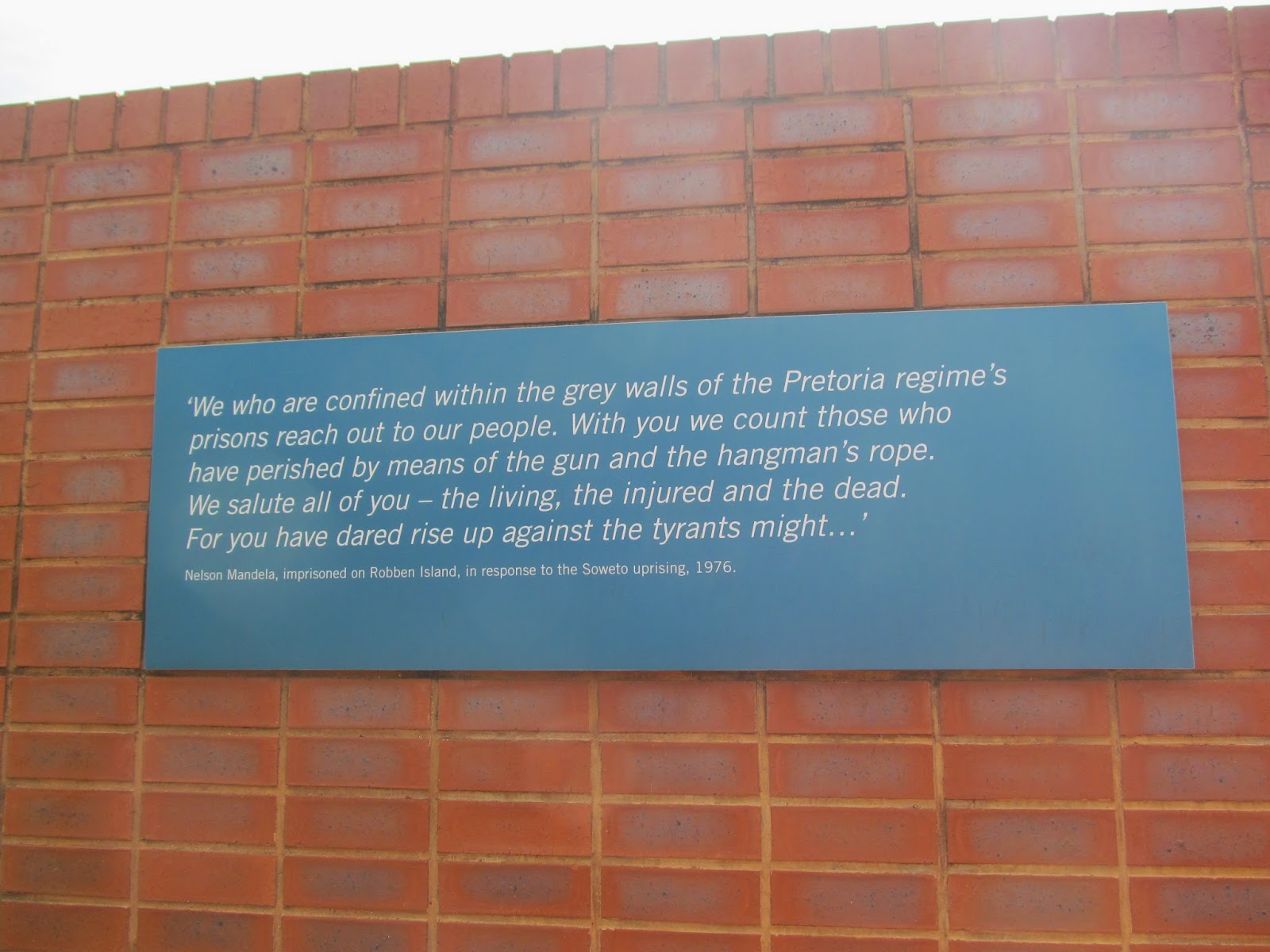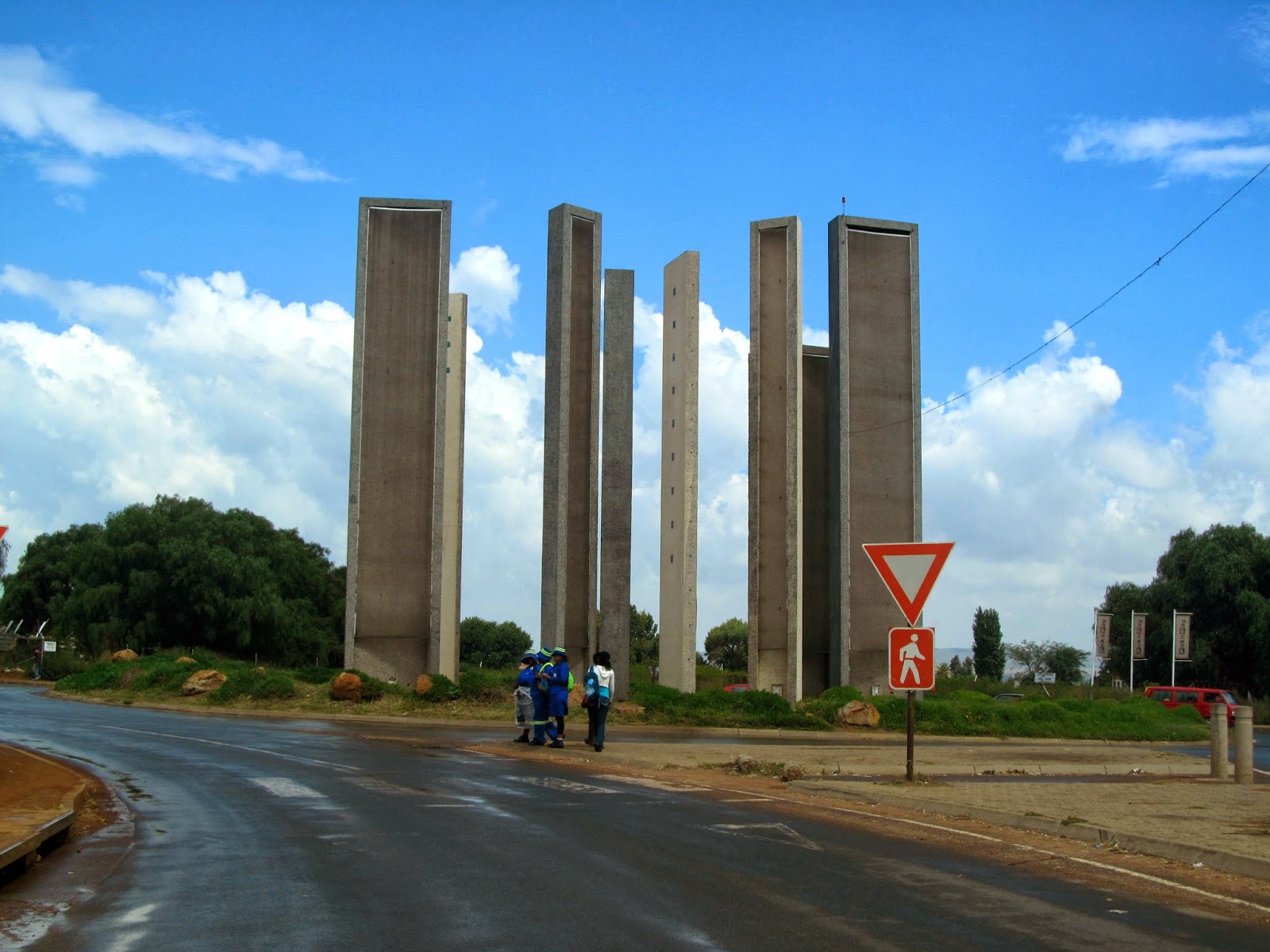March 23,
On March 19th, Wednesday Les and I went on a tour alone with a Chris Green, owner of Cashan Africa, who is director of Wilderness tours and safaris and is a qualified wilderness guide. He picked us up at Holly and Will's home at 8:15 am and we spent 12 hours with him learning about Johannesburg and Soweto and the mining industry, the different suburbs, and the history of South Africa. He took us to places we had not gone with Holly and Will and we gave the Gruvers a break for a day as entertaining for two months their parents, no matter how great we may be, is definitely a bit much for any family. We certainly are going to miss them and we hope they know how much we love each of them. We will be praying for their health and happiness in this diverse land and we hope that we have been a bright light for them in many ways . Chris Green has lived in South Africa all his life. His father was born in South Africa but received dual citizenship in Britain and went to Cambridge University, becoming an olympic bronze winner in the winter olympics in Germany bobsledding . At the University he met Jim Bailey, owner of Monahan Farms and they became best friends. Jim's wife is still seen by Lex Gruver and his friend, Byron, as they call her Mrs. B. (Barbara)
 |
| Chris Green |
You see the Farms are right next to Holly and Will. What a small world we live in! Chris Green's mother was a nurse in Canada and went to England in WWII to help the injured. She received her degree at the Univ. of Toronto. After serving in the war she met Chris's father, I believe, in Naples. Chris grew up on a farm in the British area of Johannesburg which we saw during our tour. He said in those days it was not built up and he use to ride horses on the land all around their home which was perched high on a hill overlooking the city. Chris took us to an area of the town called Maboneng which means "Place of LIghts". It use to be a rough and tumble area but has been restored to house the Arts and we ended up having lunch at The Canteen at Arts On Main which is where JIm Bailey had a publishing company still in existence today. Jim passed away in the year 2,000. He started the Drum Magazine which focused on the Black Community and it was much like Life Magazine with many beautiful colored pictures of the Black Community throughout the whole continent. Today one can make an appointment and get the front cover of the magazine from the year you were born.
Chris went on to tell us about where the names, Gauteng and Johannesburg, came from. Their meaning has to do with "the place of Gold". Which leads me to the next topic we learned about - gold and the mining industry around Johannesburg. Rand is a dutch word which means "the ridge or reef" which is where the world's largest meteor landed in Johannesburg 50 miles wide and where the largest amount of gold is found. The FNB stadium that holds 90,000 people and where Nelson Mandela's funeral was held, is exactly where that meteorite ridge landed and we stood and looked at it as Chris used maps and diagrams at the back of his van to explain the area where the meteor fell which surrounds Johannesburg.
 |
| from the stadium north is a long line of trees -120 Km long which is where the main reef was formed and largest area here where part of the reef sticks out "ridge" or "Rand". The large mine with the most gold is under the FNB Stadium.. This meteor landed in 1886. Stadium built in 1980's and upgraded in 2007 |
 |
| Chris showing us the Fools Gold, the runoff from the leaching to get at the gold. The weight of the gold goes to the bottom when washed. they use an acid leaching process to get it out which is cyanide and not mercury which was dangerous. The cyanide is treated with soda ash after getting gold so that the grass can become green again and the land is not damaged. It starts as an iron pperiteand .5 of a gram per ton ends up as gold. There are over 1,000 sand dumps here which is the runoff or fools gold from the leeching. South African gold is the highest grade and it is hard to get because it is deep in the ground. The gold is worth 1500 an ounce and there is 90th of an ounce for 1 ton of sand and there are 12 million tons of sand processed a year. |






A mine can support 130 people but not the family - it provides everything needed for the miner to do the job only. Johannesburg and Soweto are like brothers - one exists because of the other - colonial domination of the world. The Afrikans competed with the blacks for the jobs in the mines. The blacks were paid 1/7th of what the whites made. In 1959 the first bill was passed called Extension of the University Act and it was further extended in 1970's. It actually prohibited blacks from Universities. The Afrikaans got power in 1948 and by the 1950's they were the rich . More and more blacks became poorer as the British got them to do their work by going to the chiefs in the land and taxing them - The chiefs could not afford the taxes so they were told that their village men who handled the cattle and grain fields, and war, could go work the mines to pay for the taxes on the land. They worked for very little and it was demoralizing work. Their women where left poor because they could not do the work their men did. They only could handle the goats and chickens and the home. The blacks became the 200 million slaves today. 60% of all gold comes from South Africa. However, they exported the gold cheap and this is why Dubai is much better off, as they did not export their gold cheap.
 |
All around Johannesburg and surrounding areas one can see the gold dust that remains on the ridges where the mining took place
|
Next, we went to Soweto, which was my favorite part of the tour because the village area surrounding Nelson Mandelas house and Archbishop TuTu who was Nelson's neighbor growing up was filled with many local people selling their wares and we had a sweet girl named Amanda who was our guide through Nelson Mandelas home. I will never forget "What a man, what a man"
 |
| Desmond Tutu's home near Mandelas house |
 |
| sidewalk near Mandelas home |
 |
| Amanda, our guide, outside Mandela's home |
 |
| entrance and memorials |
 |
| entrance |
 |
| Bullet holes in Mandela home |
 |
| Makgatho, Nelson's son who died of HIV/AIDS |
 |
| Bed Makgatho slept in |
 |
| Mandela holding great-granddaughter, Pumla |
 |
| Winnie Mandela with daughters, Zenani and Zindzi |
 |
what the people used to protect themselves when shot at in Mandela's home
|
 |
| Prime Minister who sentenced Mandela to prison and then swore him in as President |
 |
| Mandela is honored at many Universities |
NO MAN THAT HAS BEEN IN MY LIFETIME HAS MADE A GREATER IMPACT ON MY LIFE THAN NELSON MANDELA. I guess it is because my children and grandchildren live in the same place he has walked and fought for and we all have witnessed his memorials and people who knew him and have seen what he has accomplished first hand. Les and I having toured the prison he spent 27 years of his life in also helped to form that impact on my life. It is amazing what forgiveness can accomplish for the good of mankind in this world. After all, this patterns what God has done for us when he sent His Son to forgive us of all the sin in the world.
Outside of the Mandela house, vendors from Soweta were selling their crafts and helping to bring honor to the memory of Nelson Mandela.
 |
| This man took our picture in front of Mandela's house |
 |
| This amazing man takes the dust from the mining and creates pictures and designs using a wire in these bottles . |
 |
| Unfortunately I was told these shoes in the middle were made from Springbuck - those dear animals. |
Next, we witnessed much of that sin when visiting the museum which houses the memory of Hector Pieterson and what happened to him and many others during the horrific apartheid era.
 |
| This line of grass leads to the very area where Hector was shot down and carried to hospital. |
Our lunch stop!!!
 |
| We ate under the Olive Trees |
 |
| Menu at The Canteen |
 |
| Beer Battered Hake, a delightful fish |
Regina Mundi Catholic Church that was used as a place of refuge for protestors during 1976 uprisings. It also housed a number of political rallies and is Sowetos largest Catholic church.
Walter Sisulu Square of Dedication in Kliptown where the Freedom Charter was developed and is housed. It was an alternative vision to the oppressive policies of apartheid. This charter was formed in 1955 with a crowd of over 300 people including Nelson Mandela, Walter Sisulu, Helen Joseph and Father Trevor Huddleston who signed the document.
Along side of the square is the Holiday Inn































































































No comments:
Post a Comment